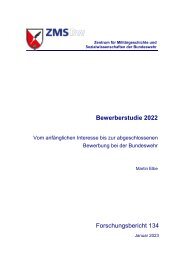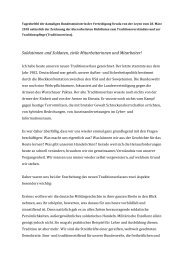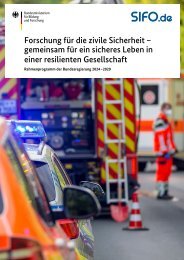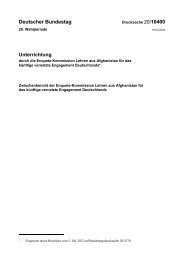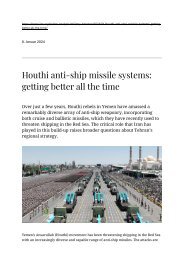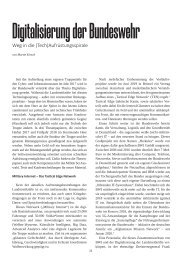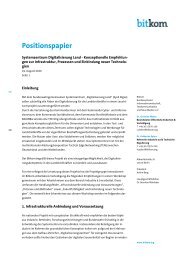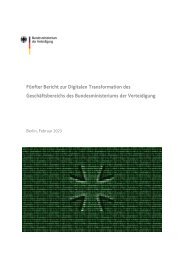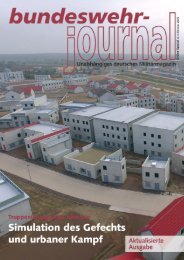EATC
Create successful ePaper yourself
Turn your PDF publications into a flip-book with our unique Google optimized e-Paper software.
aim to keep up interoperable standards for<br />
all EAATTC Participating Nations (PNs).<br />
<strong>EATC</strong> mindset<br />
The European syllabus has been developed<br />
by the <strong>EATC</strong> together with instructors from<br />
Belgium, Germany, Spain, France, Italy and<br />
the Netherlands and is based on the experiences<br />
of previous EATTs (European Air Transport<br />
Training): Zaragoza/Spain in 2013, Plovdiv/Bulgaria<br />
in 2014 and Beja/Portugal<br />
in 2015.<br />
One of the main objectives of EAATTC<br />
is to provide a robust airlift tactics training<br />
syllabus to allow aircrews to increase interoperability<br />
as well as survivability in nonpermissive<br />
environments.<br />
As the main course centre, Zaragoza AB<br />
has proven its suitability for hosting the<br />
course in terms of available airspace and<br />
support, making a very good location to conduct<br />
a highly effective training on a permanent<br />
basis. In addition to the courses pro-<br />
final check and flight Nr. 9 as graduation<br />
flight itself.At the end of the course, crews<br />
are awarded a graduation certificate, based<br />
on the number of flights and events fulfilled.<br />
Way ahead<br />
In total three EAATTCs will take place in<br />
2015 starting at the end of March at Plovdiv<br />
AB in Bulgaria, and together with the host<br />
nation the <strong>EATC</strong> has filled a key position in<br />
the organization and execution of this course.<br />
The second course is the initial multipleship<br />
course, EAATTC 2015-02.<br />
It was conducted in Spring 2015 at Orleans<br />
Air Base in France and focused on the<br />
execution of even more complex missions,<br />
including formation flights and integration<br />
of Air Transport assets in COMAOs (Composite<br />
Air Operations).<br />
The courses of 2015 will be concluded by<br />
the third and last course, focusing on singleship<br />
operations and NVG training, at Zaragoza<br />
AB again in late Summer of 2015.<br />
United States Forces are planning to deploy<br />
major parts of their AAR fleet out of<br />
Europe towards South East Asia, thus taking<br />
away a potential resource on AAR capacity<br />
on which the European Nations could<br />
always lean in the past.<br />
At the same time only 30 percent of the<br />
EU member states (MSs) operate tanker aircraft<br />
(France, Germany, Italy, the Netherlands,<br />
Spain and the UK).<br />
To minimise this capability gap, EDA has<br />
implemented an AAR project team to deal<br />
with outcomes of four different institutions<br />
on AAR matters.<br />
One of those four pillars represents the<br />
Multi-Role Transport Tanker/Air-to-Air<br />
Refuelling Operational Employment Working<br />
Group (OEWG) – led by the <strong>EATC</strong>.The<br />
OEWG’s general objective is to harmonize<br />
and – where necessary – to develop procedures<br />
and related processes to employ existing<br />
and future multi-role platforms in their<br />
dual AAR- and AT-role. But what would a<br />
vided in Spain, EDA and the <strong>EATC</strong> will<br />
continue to be strongly involved in planning<br />
and executing further EATTs in different locations.<br />
The first week of the course starts with<br />
academics spread over four half days. Some<br />
basic sorties are also flown during that first<br />
week. During the second week, the complexity<br />
of the missions increases, including<br />
low level flights, threat reaction and max<br />
effort/high performance landings.<br />
A total of 9 flights were scheduled during<br />
the first course in Spain – with flight Nr. 8 as<br />
European Air-to-Air Refuelling Training<br />
While the fighter community has trained to<br />
operate together for years (e.g.Tactical Leadership<br />
Program (TLP),Flag exercises,large<br />
NATO exercises in European airspace, etc.),<br />
the same cannot be stated for Air-to-Air refuelling<br />
(AAR), without which a lot of<br />
fighter operations would not be possible.<br />
The lessons learned from an “Unified Protector”<br />
over Libya in 2011 showed that for<br />
a smooth multinational operation we need<br />
to train together in advance. Moreover, the<br />
Tanker be good for, without a well-trained<br />
crew? This is where the European Air-to-<br />
Air Refuelling Training (EART) comes in,<br />
one important outcome of the cooperation<br />
between EDA and the <strong>EATC</strong>.<br />
Background<br />
The first EART was conducted in 2014.<br />
AAR assets from different <strong>EATC</strong> nations<br />
were already involved in the fighter exercise<br />
Frisian Flag (FF) in the years prior, but<br />
31



